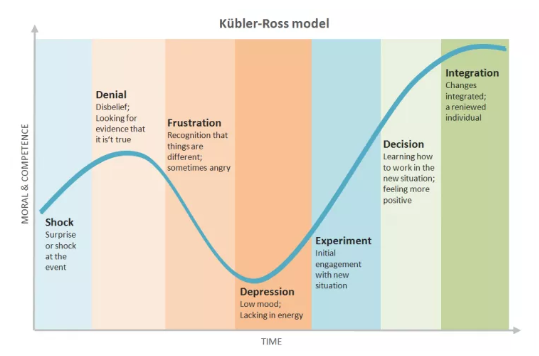
Preparing Your Software Team for Change
Change is one of the hardest things for humans to handle. We crave stability and fear the unknown. This is especially true when it comes to our livelihoods.
But companies must always be adapting their products and processes to stay ahead and succeed. The software industry is no different. In fact, software engineers see some of the most consistent change, from development processes to organizational structures to new programming languages.
There are plenty of resources out there on effective processes for dealing with change. Generally, they focus on tackling one major change at a time. But what happens when you’re in an industry where unexpected change is part of everyday life? To help you prepare your team for this world, let’s take this conversation to a more philosophical level.
Understanding the PsychologyThe first step to preparing your team for any change is for you to understand how people respond to it. The Kubler-Ross model breaks down the typical response pattern that human beings tend to display:

It’s important to note that this curve applies to teams and individuals. This means the existence, intensity, and duration of any period will be different for each individual. As we will see, identifying these differences in individuals will be key in getting through the change.
For the sake of theory, I’ll distill the model into 3 phases:
- Preamble: periods of shock and denial that change is on the horizon
- Valley of Despair: frustration, depression, and (hopefully) experimentation
- New World: deciding to and then fully integrating with the new reality
Avoid the Preamble: Value Change as the Only Constant
When change is announced, it is often met with shock and denial. The best way to minimize the difficulties that come with the first stage of the Kubler- Ross model is to change the narrative. Instead of focusing on the change itself, promote a narrative in which change is welcomed as a constant.
- Include innovation in your team’s values
- Make adaptability a key performance metric (maybe even compensate accordingly)
- Hire with flexibility as a key trait
The ultimate achievement is when you get your team members to draw a sense of pride from their ability to expect the unexpected and adapt to anything. By doing this, you remove shock and denial from the picture because even unexpected change is expected and welcomed.
Valley of Despair: Trek through with Clear Vision of the Other Side
No matter how prepared your team is for the unexpected, certain changes will send some — if not all — of your team into the valley of despair. This is the hardest part of the journey.
Vision
First and foremost your team must know where they are going and why. Every change, no matter how small, must be sold with a vision of the other side. Otherwise, why are they going through such trials and tribulations?
Everyone needs to know the vision (i.e. “the why”) on three levels:
- Why is this change an important step in reaching company goals?
- Why is this change an important step in reaching team goals?
- Why is this change an important step in reaching individual goals?
Types of Responses
To get them through the valley you need to know how different people respond to change. You are generally going to find four types of people:
- Adventurers
Early adopters who buy in easily and find success quickly. Praise them as leaders, make them the example for others to emulate.
- Attempters:
People with the spirit of adventurers but who lack the skills to find success in the new situation. They need special support from you. You need to recognize their efforts and identify their needs. They are willing, so what tools/training/guidance do they need to get there?
- Curmudgeons:
Steadfast, resistant, and potentially toxic naysayers. At best, these folks need a little more convincing or data to start experimenting; at worst, they are noxious to the rest of the team and may need more intervention.
- Caravaners:
Typical team members just trying to do their jobs successfully. They are the most easily influenced by the adventurers and curmudgeons during this time.
Getting through the Valley of Despair as a team is about driving the caravan with your adventurers leading the way and your curmudgeons bringing up the rear.
New World: Doubling Down on Experimentation.As your adventurers begin experimenting with the changes, make sure you are tracking new information to provide data and being transparent with results. If something is not driving toward the vision, do your best to figure out why. Does it need more time? More buy-in? A whole new hypothesis?
As more and more caravaners start to experiment and feel personal success (through performance metrics or simple praise) they will soon be making a real effort and integrating the change as their new reality.
—
As with everything in leadership, facing change starts with vision. With the right vision and psychological understanding of your team, you can prepare them for anything.
Not only can they take on a big change here and there, they can become a team that welcomes the challenge and even derives pride from their adaptability to achieve success.

